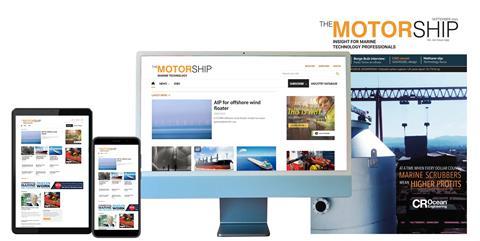- News
- Subscribe

Get full access to The Motorship content
Including the digital magazine, full news archive, podcasts, webinars and articles on innovations and current trends in the shipping industry.
- Expert analysis and comment
- Unlimited access to in-depth articles and premium content
- Full access to all our online archive
Alternatively REGISTER for website access and sign up for email alerts
- White Papers
- Industry Database
- Events

Propulsion & Future Fuels Conference 2025
The Motorship’s Propulsion & Future Fuels is the leading international conference on powering shipping’s emissions-cutting ambitions.
The 2025 Conference will take place from 25th - 27th November in Hamburg, Germany and will offer a meeting place to learn, discuss and knowledge-share the latest developments in efficient power and propulsion technology plus alternative low flashpoint and low carbon fuels.
Click here for more information
Accelerating the shipping energy transition through decisive emissions policies

Fossil fuels and sustainable fuels are on the path to cost parity within the next few decades as a result of evermore stringent international regulations. Mikael Wideskog, director, sustainable fuels & decarbonisation at Wärtsilä delves into where the industry needs to focus to most effectively harness this parity, namely: investing in fuel flexible technology, addressing the cost of transition and fostering a system of intra and inter-sector collaboration.
The essence of an industry analysis shows that cost parity could be reached between sustainable shipping fuels and fossil fuels by 2035 as decisive emissions policies and regulatory pressure ramp up.
According to recent research from a Wärtsilä report published on sustainable shipping fuels, regulations like the EU Emissions Trading Scheme (ETS) and FuelEU Maritime Initiative (FEUM) could cause a near-doubling of the cost of using fossil fuels by 2030. Furthermore, despite sustainable fuels forecasted to remain three to five times more than today’s fossil fuels, the cost gap between sustainable and fossil fuels could close with the introduction of further regulations.
Continue this article…
Already subscribed? SIGN IN now

Register for a FREE one-month trial to continue this article
Want to read more before deciding on a subscription? It only takes a minute to sign up for a free account and you’ll get to enjoy:
- Weekly newsletters providing valuable news and information on the shipping sector
- Full access to our news archive
- Live and archived webinars, podcasts and videos
- Articles on innovations and current trends in the shipping industry
- Our extensive archive of data, research and intelligence
Get more free content sign up today
Ready to subscribe? Choose from one of our subscription packages for unlimited access!

